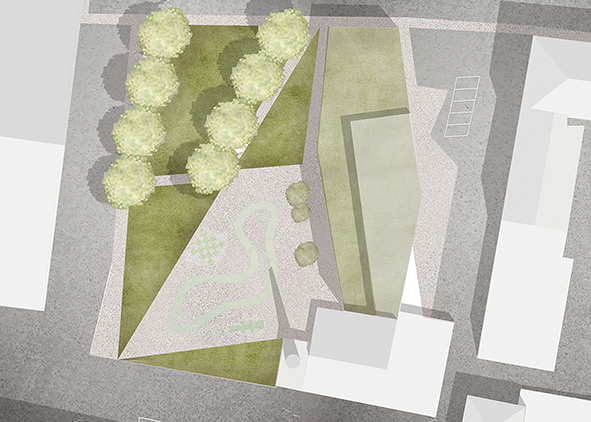Urban regeneration. Benefits of nature-based solutions
DOI:
https://doi.org/10.19229/2464-9309/9162021Keywords:
nature-based solutions, urban regeneration, well-being, heat island, resilienceAbstract
Today’s urban environment features several critical issues related to what in Italy is called ‘cementification’: among the main ones, the phenomenon of heat islands, the cause of several problems related to citizens’ health, especially for the weaker population groups such as children and elderly people. This paper presents the results of a research focused on identifying a combination of nature-based solutions, offering good benefits both from the point of view of improving microclimate comfort and from the point of view of psychological comfort for the people who will use the regenerated areas.
Downloads
Article Metrics Graph
References
Abdi, B., Hami, A. and Zarehaghi, D. (2020), “Impact of small-scale tree planting patterns on outdoor cooling and thermal comfort”, in Sustainable Cities and Society, vol. 56, 102085, pp. 1-12. [Online] Available at: doi.org/10.1016/j.scs.2020.102085 [Accessed 23 April 2021].
Beatley, T. (2011), Biophilic Cities, Integrating Nature into Urban Design and Planning, Island Press, Washington.
De Capua, A. and Errante, L. (2019), “Interpretare lo spazio pubblico come medium dell’abitare urbano | Interpreting public space as a medium for urban liveability”, in Agathón | International Journal of Architecture, Art and Design, vol. 6, pp. 148-161. [Online] Available at: doi.org/10.19229/2464-9309/6142019 [Accessed 23 March 2021].
EEA – European Environment Agency (2019), The European Environment – State and outlook 2020 – Knowledge for transition to a sustainable Europe, Publications Office of the European Union, Luxembourg. [Online] Available at: eea.europa.eu/publications/soer-2020 [Accessed 17 April 2021].
Morabito, M., Crisci, A., Gioli, B., Gualtieri, G., Toscano, P., Di Stefano, V., Orlandini, S. and Gensini, G. F. (2015), “Urban-hazard risk analysis – Mapping of heat-related risks in the elderly in major Italian cities”, in PLoS one, vol. 10, issue 5, e0127277, pp. 1-18. [Online] Available at: doi.org/10.1371/journal.pone.0127277 [Accessed 15 March 2021].
Neonato, F., Tomasinelli, F. and Colaninno, B. (2019), Oro Verde – Quanto vale la natura in città, Il Verde Editoriale Milano.
Palla, A. and Gnecco, I. (2018), “Green Roofs to Improve Water Management”, in Pèrez, G. and Perini, K. (eds), Nature Based Strategies for Urban and Building Sustainability, Butterworth-Heinemann, pp. 203-213. [Online] Available at: doi.org/10.1016/B978-0-12-812150-4.00019-7 [Accessed 15 April 2021].
Pérez, G. and Perini, K. (eds) (2018), Nature based strategies for urban and building sustainability, Butterworth-Heinemann. [Online] Available at: doi.org/10.1016/C2016-0-03181-9 [Accessed 25 March 2021].
Perini, K. (2013), Progettare il verde in città – Una strategia per l’architettura sostenibile, FrancoAngeli, Milano.
Polo-Labarrios, M. A., Quezada-García, S., Sánchez-Mora, H., Escobedo-Izquierdo, M. A. and Espinosa-Paredes, G. (2020), “Comparison of thermal performance between green roofs and conventional roofs”, in Case Studies in Thermal Engineering, vol. 21, 100697. [Online] Available at: doi.org/10.1016/j.csite.2020.100697 [Accessed 25 March 2021].
Scudo, G. and Ochoa De La Torre, J. M. (2003), Spazi verdi urbani – La vegetazione come strumento di progetto per il comfort ambientale negli spazi abitati, Esselibri-Simone, Napoli.
Taha, H. (1997), “Urban climates and heat islands – Albedo, evapotranspiration, and anthropogenic heat”, in Energy and Buildings, vol. 25, issue 2, pp. 99-103. [Online] Available at: doi.org/10.1016/S0378-7788(96)00999-1 [Accessed 23 April 2021].
Thomsit-Ireland, F., Essah, E. A., Hadley, P. and Blanuša, T. (2020), “The impact of green facades and vegetative cover on the temperature and relative humidity within model buildings”, in Building and Environment, vol. 181, 107009. [Online] Available at: doi.org/10.1016/j.buildenv.2020.107009 [Accessed 23 March 2021].
Williams, F. (2017), The nature fix – Why Nature Makes us Happier, Healthier, and more Creative, W. W. Norton & Company, New York.
Yin, J., Yuan, J., Arfaei, N., Catalano, P. J., Allen, J. G. and Spengler, J. D. (2020), “Effects of biophilic indoor environment on stress and anxiety recovery – A between-subjects experiment in virtual reality” in Environment International, vol. 136, article 105427, pp. 1-10. [Online] Available at: doi.org/10.1016/j.envint.2019.105427 [Accessed 14 April 2021].

Downloads
Published
How to Cite
Issue
Section
License
This Journal is published under Creative Commons Attribution Licence 4.0 (CC-BY).
License scheme | Legal code
This License allows anyone to:
Share: copy and redistribute the material in any medium or format.
Adapt: remix, transform, and build upon the material for any purpose, even commercially.
Under the following terms
Attribution: Users must give appropriate credit, provide a link to the license, and indicate if changes were made; users may do so in any reasonable manner, but not in any way that suggests the licensor endorses them or their use.
No additional restrictions: Users may not apply legal terms or technological measures that legally restrict others from doing anything the license permits.
Notices
Users do not have to comply with the license for elements of the material in the public domain or where your use is permitted by an applicable exception or limitation.
No warranties are given. The license may not give users all of the permissions necessary for their intended use. For example, other rights such as publicity, privacy, or moral rights may limit how you use the material.


















































































